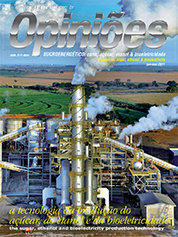Marcos Torres
Director of Etha - Treinamentos e Projetos
Op-AA-27
Influence on the balance of mass and process steam
Since 2000, and up until now, we have had the opportunity to replace the main equipment of mills and distilleries built around 1980, as well as of new units, using a conceptual project involving all products and sub-products one can obtain. Apart from decisions on the use of a crushing mill or a diffuser in the power station and boiler, some concepts should be remembered.
Condensation or extraction turbine? A condensation turbine is simply an expression. Condensation inside the turbine is neither desired nor allowed in excess of inevitable and acceptable limits (in the magnitude of 3%). Therefore, steam at the exit point is always steam – with a higher or lower degree of overheating, and with pressure higher or lower than the local atmospheric pressure.
The highest cost in any steam cycle occurs when transforming liquid water into saturated steam in the boilers. The benefit lies in condensing it for the processes one wants to implement in the mill. In the mills one needs “process steam” for unit operations. The main condenser and the main process steam generator is the pre-evaporator of juice that, in turn, generates vegetal steam for all other processes such as distillation, crystallization, heating, evaporation and drying.
To cogenerate is to overheat steam in the serpentines and then expand it on the turbine blades, producing mechanical energy and electricity. However, one may never allow a portion of this steam to condense in condensers at a pressure lower than that needed for the processes, or even at below atmospheric pressure. This would imply wasting energy and heating the environment. Conventional thermoelectric plants that run on coal, oil, or even nuclear power, do that because there are no alternatives.
One should not forgo heating the juice – necessary to eliminate micro-organisms and to maximize the fermentation yield – using the argument of saving steam to later expand it in the turbine at below atmospheric pressure and also, to cease producing dry yeast, protein salts or refined crystals due to the lack of steam. What one should do, though, is to condense all the outcoming steam from the turbine without losing mass and without replacing demineralized water, while making good use of all the vegetal steam.
One needs to plan strategically to aggregate value to one’s products. For that, one will need energy to “produce” rather than to “process”. Marketing-oriented technological research may define products and brands that use all this energy, transforming it into wealth. Having set the steam exit condition from the turbine at 2.5 bar and 130ºC, for example, one would set the entry condition that defines the boiler characteristics, the piping and all accessories, determining the amount of investment.
One must draw up a table in which for each degree of overheating to be assessed in the interval between 480 and 540ºC, there will be the minimum pressure required by the turbine. This pressure is determined by the quality of the project and the construction of the turbine, which define its isentropic yield.
One must be alert with respect to this concept, because one can easily get mixed up thinking that the higher the pressure the better, but in fact it is exactly the other way round. Good turbines require lower pressures. To expand steam is easy, and even a reducer valve can do this. The secret is to transform enthalpy into torque and rotation.
The calculation of specific steam consumption in kgV/h for each generated kW must be done for each combination of temperature and yield. In mills in which fuel is part of the raw material, one should use specific bagasse consumption rather than steam consumption. Running these numbers, one will find values of 2.6 to 3.0 ton/h of bagasse for each generated MW.
A diference in magnitude of 15% would be decisive in choosing a temperature/yield pair (pressure is a consequence) if one were in countries that practice globalized interest rates applied to major investments. Since that is not the case, the task is difficult and probably one will have to choose a more modest technical solution to make payment of interest feasible in the project’s cash flow.
Another important warning is to require of turbine manufacturers contractual warranties concerning yields, given that they are fundamental in the economic success of an undertaking. The measurement methods of guaranteed parameters and their precision must be clear, and the contracts must specify experienced arbitration chambers rather than public county courts.
To make the needed improvements to the process, such as reducing particulate emissions in the chimney, eliminating the sourcing of water, eliminating the generation of vinasse and producing protein salts to meet the world demand for protein, all the energy contained in the turbines’ would be needed. Sugarcane has always been associated with sugar and salts have always been a hindrance for the exhaustion of bigger syrup.
In future, perhaps these salts contained in sugarcane – about 13% of the sugar contained in sugarcane –, along with the yeast produced in the fermentation, will constitute one’s greatest asset value. To sell protein will be better than to sell energy in the form of ethanol, electricity or saccharose.




